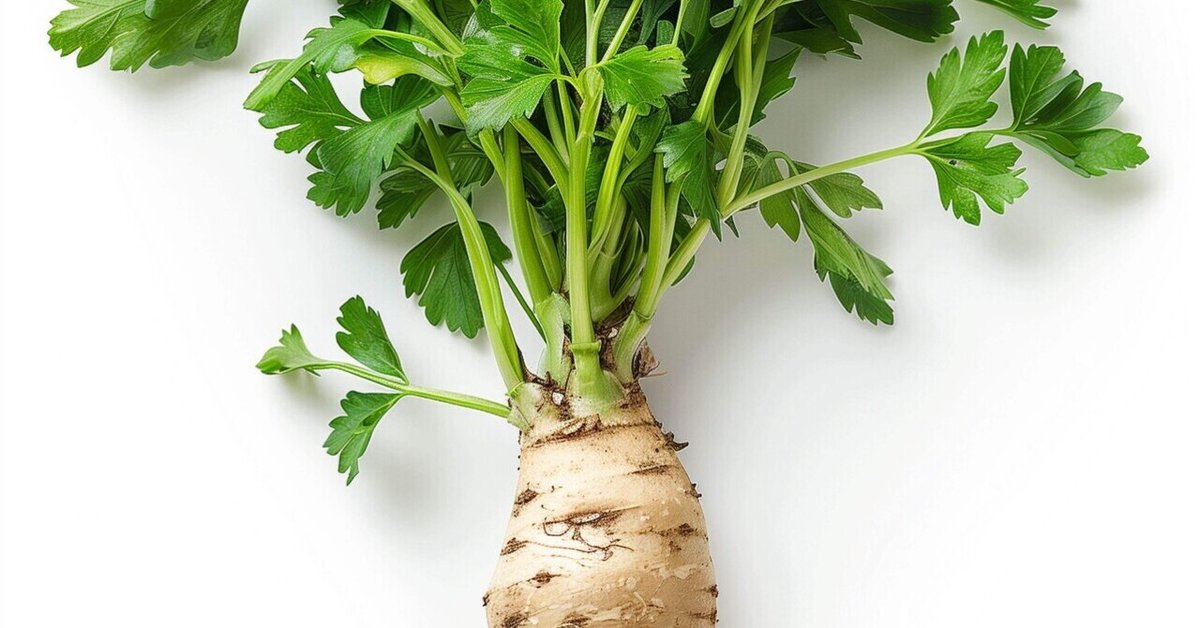
セルリアック(Celeriac)/Celery root, Knob celery, Turnip-rooted celery/Apium graveolens var. rapaceum
(基本情報 Description)
イタリア料理やエスニック料理のブームで、ずいぶんと外来の新しい野菜が出回るようになったけど、この「セロリアック」は日本ではまだまだ馴染みの薄い野菜の一つ。セロリ(セルリ)は日本でもポピュラーな野菜だが、セルリアックはセロリにごく近い近縁種だ。ただ、普通のセロリのように茎を食べるのではなく、肥大した根茎部分を食用にする。地中海沿岸が原産と推測されていて、北アフリカやヨーロッパでよく栽培されている。名前でお分かりの通りセロリの仲間で、根っこが丸く肥大して食用になる。フランスではceleri-rave(蕪セロリ)、ドイツではKnollensellerie(球セロリ)と、様々な視点による命名があって面白い。celery-rootという言い方もあって日本での根セロリというのはこれの直訳だろう。この種は茎の基部から細い根が生え、地面の方に向かって肥大するように発達する。
日本人にとってセロリと言えば、茎を食べるあのセロリのことだけど、実は、ヨーロッパではセロリといった場合、茎を食べるセロリとこのセルリアックの両方を思い浮かべる人が多い。元はと言えば、地中海沿岸に自生していた雑草から選別された栽培品種だからだ。野生のセロリ (Apium graveolens)は、古代エジプトやギリシャでは薬草として広く知られていた。後に(多分イタリアで)、茎が柔らかく発達したものを選別したのが茎セロリで、根が肥大したものを選別したのがセルリアックとして、野菜扱いされるようになった。セロリという名称もギリシャ語が起源だ。そこから、フランスやドイツに伝わり、西アジアや北アメリカでも栽培されるようになった。だからどちらもセロリはセロリなのだ。日本には茎のセロリだけが最初に紹介されたので、日本ではセロリは茎を食べるものと認識された訳だ。後から紹介された「セルリアック」の方は「セルリ」と原産地の発音を引きずっている。
With the boom of Italian and ethnic cuisine, many new foreign vegetables have become available, but celeriac.(root celery) is one of the vegetables that is still not familiar in Japan. Celery (stem celery) is a popular vegetable in Japan, but celeriac(root celery) is a close relative of celery. However, unlike regular celery, the stalk is not eaten, but the swollen root is edible. It is believed to have originated on the Mediterranean coast, and is commonly cultivated in North Africa and Europe. As the name suggests, it is a member of the celery family, with edible round, swollen roots. It is interesting to note that it has been named after various perspectives, such as celeri-rave (turnip celery) in France and Knollensellerie (bulb celery) in Germany. It is also called Japanese term “ne-serori”, which is probably a direct translation of the celery(serori) root(ne). This species has thick stem block that grow from the base of the stem and develop by swelling toward the ground with thin roots.
For Japanese people, celery means the celery whose stems are eaten, but in fact, when people in Europe say celery, they think of both the celery whose stems are eaten and this celeriac. It was originally a cultivated variety selected from a weed that grew wild on the Mediterranean coast. Wild celery (Apium graveolens) was widely known as a medicinal herb in ancient Egypt and Greece. Later (probably in Italy), celery with soft and developed stems was selected as stalk celery, and celeriac was selected from the roots that grew thickly, and they came to be treated as vegetables. The name celery also originates from Greek. From there, it spread to France and Germany, and came to be cultivated in Western Asia and North America. So both celeries are celery. Only celery whose stems were introduced to Japan first, so celery was recognized in Japan as something that the stems are eaten. The "sereriakku(celeriac)" that was introduced later still carries the pronunciation of its place of origin, "sere(sele)".
(栽培情報 Cultivation)
ヨーロッパでは、春蒔きして冬に収穫するか、冬に蒔いて春収穫する。栽培そのものはセロリと同種なので、セロリに準じる。寒さには非常に強い反面、暑さに弱いので、夏に高温にさらさないようにする必要がある。
In Europe, it is planted in spring and harvested in winter, or planted in winter and harvested in spring. It is cultivated in the same manner as celery, as it is the same species. It is very resistant to cold, but weak to heat, so it is necessary to avoid exposing it to high temperatures in summer.
(利用のアイデア Uses)
セルリアックは普通のセロリとは違い、葉は退化して苦味が強くなっている。しかも流通上は大抵葉は切り落とされてしまっていることが多いが、運良く葉付きが手に入ったら、香味は十分に豊かで強いので、スープストックを取るのに使うと良い。台所に吊るしておいて、乾燥させてからブーケガルニに使う手もある。
主役の根茎は、ごつごつの皮なので厚めに剥いて調理する。皮を剥くと、外見からは想像できない白く滑らかな実が現れる。赤いシミや空洞が入っている場合があるが、これは水不足の為。この野菜は生育に水を大量に必要とする様で、不足すると、空洞ができた上に渋みが強くて食べ難くなってしまうようだ。レストラン用に出荷される奴はその辺、栽培にも気が使われていて滑らかで実が大きい。
薄く切れば、コールスローのように生でも食べられるが、辛いと思う人は、ごく軽く茹でてサラダにするかマリネにして食べると良い。セロリより柔らかく上品な味わいだ。セロリと同じくリンゴとの相性は抜群なので、りんごのスライスと和えても良い。生は変色しやすいので、下拵えの際には、水に放すか、レモン汁などで和えてもおくと良い。
勿論煮込んだり、フライ、ピュレにしても美味しい。カレーやポトフの実、ポタージュなどで楽しめる。ベーコンや塩豚とタマネギを炒めた所にセロリアックの薄切りを加えて白ワインで煮込み、ポテトマッシャーで荒くつぶしてからパスタと絡めるのも秀逸だ。珍しいところでは和風のレシピを2品。千六本に切ったものをオリーブオイルと鷹の爪で炒め、しんなりしたら醤油を注いで更に炒め、最後にごま油をまわしかける。セロリアックのキンピラだ。また、ピュレにしたものを鰹出汁に入れ白みそも溶いて、とろ火で香りと濃度が出るまで煮て椀に入れ、葉のみじん切りを散らす。ちょっと変わった摺り流し汁が出来る。
フライドポテトやマッシュポテトのように調理しても、じゃがいもには無い香りが引き立って、素敵な味わい。芋っぽい食感の割には澱粉を含まないので、グルテンフリーの料理やダイエット食に採用しても良いだろう。
Celeriac is different from ordinary stem celery in that its leaves have degenerated and become bitter. Moreover, the leaves are usually cut off when it is sold, but if you are lucky enough to get celery with the leaves on, it has a rich and strong flavor, so it is good to use it to make soup stock. You can also hang it in the kitchen to dry it and use it to make bouquet garni.
The main ingredient, the rhizome, has a rough skin, so it is peeled thickly before cooking. Once peeled, a smooth white fruit appears, which is unimaginable from its appearance. It may have red spots or hollows, but this is due to lack of water. This vegetable requires a lot of water to grow, and if there is a lack of water, hollows will form and the fruit will become very bitter and difficult to eat. The ones shipped to restaurants are grown with care, and the fruit is smooth and large.
If you slice it thinly, you can eat it raw like coleslaw, but if you find it too spicy, boil it very lightly and eat it as a salad or marinade. It has a softer and more refined taste than celery. Like celery, it goes well with apples, so you can mix it with sliced apples. It discolors easily when raw, so when preparing it, it is best to soak it in water or mix it with lemon juice.
Of course, it is also delicious when stewed, fried, or pureed. It can be enjoyed in curry, pot-au-feu, and potage. It is also excellent to add thin slices of celeriac to fried bacon, salted pork, and onions, stew them in white wine, roughly mash them with a potato masher, and mix them with pasta. There are two unusual Japanese recipes. Cut it into 1,600 pieces and fry it with olive oil and chili pepper, and when it becomes soft, pour in soy sauce and fry it further, and finally drizzle with sesame oil. It's celeriac kinpira. You can also add the puree to bonito stock, dissolve white miso in it, simmer over low heat until it becomes fragrant and thick, then serve in a bowl and sprinkle chopped leaves on top to create a slightly unusual “surinagashi(soup)”.
(関連情報 Related information)
※Amazonのアフェリエイトに参加しています。もしご購入の際はここからクリックしてご購入いただけると、コーヒー代の足しになるので、嬉しいです。ちなみに僕はコーヒー依存症です。
*I participate in Amazon affiliate programs. If you purchase this product by clicking here, it will help pay for my coffee, so I would be verhy happy. By the way, I am addicted to coffee.
この記事が気に入ったらサポートをしてみませんか?
